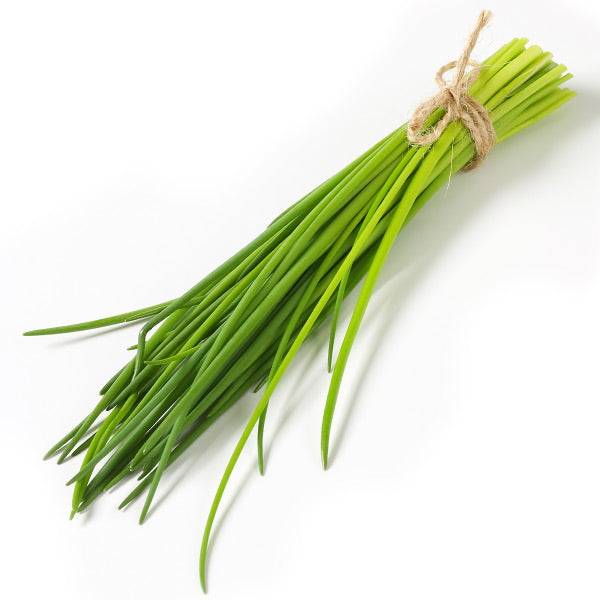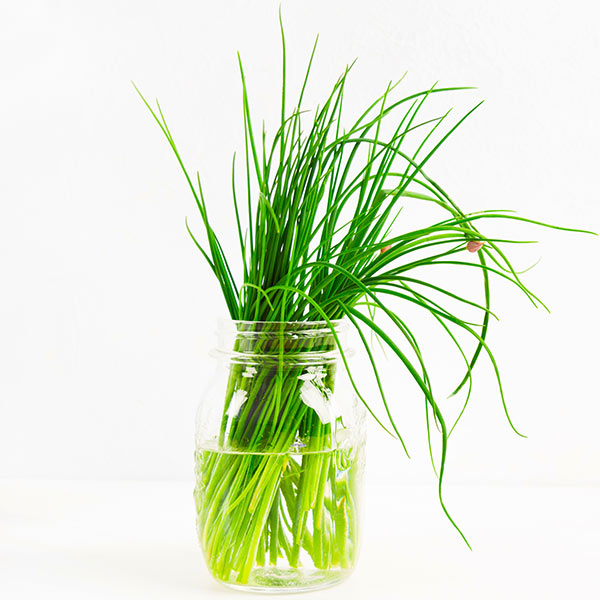How to Grow Chives from Seed
- Latin name: Allium schoenoprasum
- Days to Maturity: Start harvesting after 60 days
- Hardiness Zone: Perennial, 3-9
- Planting Depth: ¼-½”
- Plant Spacing: 6-12”
- Growth Habit: Upright
- Germination Time: 10-14 days
- Soil Preference: Rich in organic matter, well-draining
- Temp Preference: Warm
- Light Preference: Full sun to partial shade
- Color: Green
- Flavor: A lovely onion flavor without the onion spice
- Availability: Buy Chives Seeds

>>> See Full Herb Grow Guide List <<<
Difference Between Chives and Garlic Chives
Although the difference between garlic chives (Allium tuberosum) and chives is minimal in terms of growing and caring for in an herb garden, their appearance is noticeable. Garlic chives have flatter shoots, known as scapes, and produce more of a bulb where the strong garlic flavor lies. It's lowest hardiness zone is 4 as opposed to 3 with regular chives, but that distinction isn't too important as they are usually treated as annual, planted fresh with new seeds the following year. If you are growing garlic chives, take the same approach as you would with regular chives.

Sowing Chives Indoors and Outdoors
Indoors - Start seeds in plug trays 6 to 8 weeks before the first frost of the year, so that when soil is workable, you can transplant it outdoors in a garden bed or into a growing container that lives outdoors. Yes, you can grow chives indoors in a growing container, but chives need a sufficient amount of sunlight per day, about 6 to 8 hours. If you are planning to grow chives indoors indefinitely, simply plant the seed in the container that it will live it's entire lifecycle in.
Outdoors - Start chives outside as soon as the earth is workable. Chive seeds germinate in cooler temperatures in 14 days. Warm to temperate seasons are ideal to maintain growth. Chives grow in clusters, so, space chive clusters about 6" to allow spreading. Chive seedlings will begin thin and wispy but overtime will thicken and become more tenacious.
Growing and Maintaining Chives
Chives will thrive in the more temperate climates of spring and fall, but will grow throughout summer. Chives are a remarkable herb in that they tolerate heat as well as cold. Water deeply during the summer hot and dry months. Harvest as the plant produces. If chives bloom, cut before they go to seed, as it has the potential to take over your garden the following spring. Follow these same guidelines for growing indoors as well. If your chives begin to turn yellow and their scapes become limp, it most likely needs more sunlight.
Harvesting Chives
When harvesting your chive herb shoots, don't trim all the way to the base until the end of the season. Snip off bunches of chives just about a third of the way up the shoot. Don't harvest more than 80% of the plant at once.
Storing Fresh and Frozen Chives
Fresh chives shoots can be stored for several days on your counter-top by standing them in a glass and filling part-way with water. Shoots with and without blooms can be stored this way. Chives that haven't bloomed can be wrapped in a moist paper towel and stored in the refrigerator in a resealable bag.
Freezing fresh chives is a common practice. Be sure to finely chop chives after washing; this helps to preserve the texture as much as possible. Take an ice cube tray (or any other container that may help you portion out your saved chives) and fill the cells with you chopped chives. Fill the tray with just enough olive oil or water and let them freeze over. Frozen chives remain good for up to 6 months in your freezer.

Possible Chive Pests
Thrips - these small black bugs will feed on your tender scapes, leaving behind holes and spots on them. Gently remove them by hand, and apply a soapy solution to affected areas and to the base of your plant(s). This should ward off any additional thrips. Oil solutions instead of soap also works.
Slugs - these small fleshy creatures are known to feat on chives and other herbs at night, hiding beneath the soil during the day. Among the best preventative measures are a copper-plate perimeter and a beer trap. Creating some kind of copper plated perimeter around your herbs will inhibit slugs, as the copper is painful for the slugs to travel over. A beer trap is a small container of beer placed in and around your herbs. Slugs will be attracted to the beer over your chives and other herbs.
Maintaining Chives as a Perennial
If you live in zones 3-9, which is likely, you may opt to keep chives growing year after year by treating it as a perennial. By season's end, when chives has stopped producing, simply trim away all of the excess shoots and foliage. Chives will return the following spring, as its roots system is intact beneath the soil. Just be sure not to till this piece of ground or the roots system will become damaged and you'll have to replant chives in the spring.
Chive Flowers as a Companion Plant
Chives flowers are one of the top nectar-producing flowers out there. So, it makes it a terrific companion plant for your garden as a whole. It will attract loads of pollinators to your garden.

Explore these Chive Herb Seed Varieties:
- Organic Chives Herb Seeds
- Chives Herb Seeds
- Organic Garlic Chives Herb Seeds
- Garlic Chives Herb Seeds











